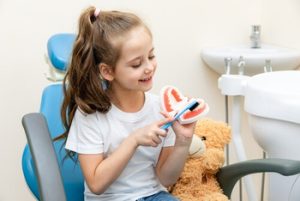Seeing your baby’s first tooth appear can be exciting but also confusing for many parents. Understanding baby first tooth symptoms allows you to identify early teething signs and respond confidently. As babies start teething, their gums and behaviour may change in ways that catch caregivers off guard. Recognising these changes early ensures that your child stays comfortable and cared for during this important stage. With helpful strategies and professional dental guidance, you can support your child through the process while protecting their developing smile.
Recognising Early Baby Teething Symptoms
Identifying the symptoms as your baby’s teeth begin emerging helps you prepare and respond appropriately. Observing their gums, behaviour, and general comfort level offers valuable clues.
Gum Changes Signal the Start
One of the first signs and symptoms parents may notice involves changes to the baby’s gums. The area where the erupting tooth is pushing through may look slightly swollen and red. This tenderness makes the baby’s mouth more sensitive to touch. Gently rubbing your baby’s gums with a clean finger may reveal a firm bump under the surface, signalling where the tooth will soon erupt. Monitoring these subtle gum shifts allows you to stay ahead of emerging discomfort.
 Increased Drooling and Chewing Behaviours
Increased Drooling and Chewing Behaviours
As teething babies work through discomfort, increased drooling becomes common. Excess saliva often leads them to chew on fingers, toys, or clothing for relief. Some may repeatedly suck fingers or bite on soft objects to counteract gum pressure. While sucking fingers can provide temporary comfort, supervising these habits helps reduce unnecessary irritation. Providing safe chewing alternatives minimises wear on the baby’s gums while protecting their developing teeth.
Sleep Disturbances and Fussiness
Teething symptoms often disrupt a baby’s regular sleep pattern. As the erupting tooth applies pressure beneath the gum surface, your child may wake more frequently or struggle to settle. Irritability may also increase during both day and night due to persistent gum soreness. Offering comfort and sticking to a consistent routine can ease these temporary changes. Tracking sleep disruptions can also help confirm that teething is the likely cause.
Facial Rubbing and Ear Tugging
Teething discomfort sometimes radiates beyond the gums. Babies may tug at their ears or rub their cheeks when the pain spreads through surrounding tissues. This pulling behaviour may appear alongside other symptoms such as red swollen gums or slight fever. While these reactions are typically harmless, consult your child’s dentist if symptoms persist or worsen. Being attentive to these movements helps distinguish teething from other conditions.
Slight Fever and Other Symptoms
Most babies experience mild temperature increases during teething. A slight fever, pulling on ears, and overall fussiness often accompany the arrival of new teeth. However, any high or prolonged fever warrants medical attention to rule out illness unrelated to teething. Other symptoms like disrupted feeding or temporary changes in appetite may also occur. Staying observant allows you to provide the right support without missing more serious health concerns.
The Typical Teething Timeline
Teething usually begins around four to seven months of age. The central incisors are often the first teeth to erupt, followed by lateral incisors, first molars, and canines. By the time most babies reach 24 to 30 months of age, a few teeth or even a full set of baby teeth may be present. Tracking the order and timing of each erupting tooth helps ensure normal dental development.
Effective Ways to Support Your Teething Baby
Once you identify teething signs, using the right comfort strategies and dental care techniques will help manage discomfort while protecting your baby’s teeth and gums.
 Safe Soothing Techniques for Sore Gums
Safe Soothing Techniques for Sore Gums
Using a clean finger to gently rub your baby’s gums can provide immediate relief. The gentle pressure helps counteract swelling while calming irritated tissues. A chilled teething ring or cold spoon also offers effective comfort when placed briefly against the gums. These cooling methods help numb the soreness naturally. Always ensure that teething rings are intact and free of cracks to eliminate any potential choking hazard.
Choosing the Right Teething Tools
Teething rings and toys provide safe outlets for your baby’s need to chew. Selecting products made from BPA-free silicone or soft rubber ensures your child can bite down without risking damage to the gums. Avoid toys with small parts that present a potential choking hazard. Regularly inspect teething tools for wear and sanitise them frequently to maintain good hygiene during this stage.
Pain Relief Options for More Severe Discomfort
For teething babies experiencing more significant pain, over-the-counter pain relief may be helpful under professional supervision. Always consult your child’s dentist before using teething gels or oral pain relievers to ensure appropriate dosage and safety. Some teething gels contain ingredients unsuitable for babies under certain months of age. Professional advice ensures safe pain relief without introducing unnecessary risks.
Introduce Dental Care Habits Early
Oral hygiene should start even before the first teeth break through. Wiping your baby’s gums gently with a soft, damp cloth twice a day reduces bacteria build-up and supports gum health. Once the first tooth appears, use a small pea-sized amount of low-strength fluoride toothpaste on a baby toothbrush. As your child grows, switching to standard-strength fluoride toothpaste with a pea-sized amount ensures proper protection against tooth decay.
Starting Flossing and Monitoring Tooth Growth
Once two teeth touch, parents can begin gently flossing between their child’s teeth to help prevent early cavities. Regular observation of your child’s gums allows you to track how their teeth break through and monitor for any issues requiring professional attention.
 Schedule Dental Visits for Professional Care
Schedule Dental Visits for Professional Care
Early dental visits help ensure your child’s teeth and gums are developing correctly. A dental practitioner can check for signs of tooth decay, address any concerns, and provide tailored guidance for baby teething care. Routine visits also familiarise your child with dental care environments, reducing anxiety in future appointments. Prioritising professional care early supports long-term dental health and allows potential problems to be identified before they progress.
Help Your Baby Smile Comfortably Through Teething
Watching your baby’s first teeth appear is a meaningful milestone, but it comes with new responsibilities for care. By recognising teething symptoms early and using safe comfort techniques, you can minimise your child’s discomfort while protecting their developing smile. Starting healthy oral care routines now builds habits that support strong teeth well into adulthood. If you need expert guidance or professional support during your baby’s teething phase, our clinic is here to help. Call us today on (02) 9054 5281 to schedule an appointment.
References
https://www.webmd.com/parenting/baby/teething-symptoms-remedies
https://www.mayoclinic.org/healthy-lifestyle/infant-and-toddler-health/in-depth/teething/art-20046378


 Increased Drooling and Chewing Behaviours
Increased Drooling and Chewing Behaviours Safe Soothing Techniques for Sore Gums
Safe Soothing Techniques for Sore Gums Schedule Dental Visits for Professional Care
Schedule Dental Visits for Professional Care